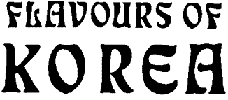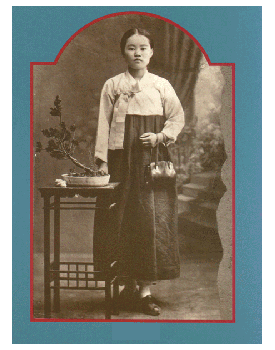




Halmoni, My Grandmother


Bok Dok Sur on arrival in Hawaii in the early 1920's
My great-grandfather Kim Kyong-bong was a yangban-- an aristocratic landowner in Yi Dynasty Chosun at the turn of the century. The family owned two homes, the main agricultural estate near Pusan, and also a summer house at Sochang, in the cool mountains between Pusan and Ulsan. Already, however, an ancient and proud traditional culture was on the verge of collapse: nonetheless, it was a bold, brave, and defiant act when my grandmother, Bok Dok Sur, then a young girl only sixteen years old, sent her photograph to the American territory of Hawaii, received one in exchange, and by this means, became one of the so-called "Korean picture brides" and came to a new land to start a new life.
As a young boy growing up on the West Coast of America more than half a century later, those events and places were so far away and distant to me as to be almost non-existent. After all, three generations and a continent is far enough away in time and space. Moreover, third generation Korean on my mother's side, third generation French on my father's, I (and my brother David and sister Michele) never really considered ourselves to be anything other than pure American (whatever that is). Korea, its history and culture, remained alien to us, and we, sadly, were ignorant of it.
And yet: did we not have a Korean grandmother whom we called Halmoni (Korean for grandmother) and who spoke mainly Korean to my mother and only broken "pidgin" English to us? As children, we saw Halmoni often at her home in Los Angeles, and it was there that we always enjoyed the most sumptuous Korean feasts.
Halmoni was born in 1907, some three years before the Japanese officially annexed Korea and began their brutal and iron-fisted "japanization" of the country. Already, though, an ancient and traditional society was on the verge of collapse. It was not easy for a young girl growing up in these turbulent times. Coming from her traditional and privileged background, she was expected to conform to the neo-Confucian mores and customs relating to the role of females. Women of her class, for example, were not even allowed outside the household compound; they hardly had the opportunity to meet or talk to men; and it was expected that they would submit to arranged marriages when they were fifteen or sixteen years old and then go and live with their husbands' families, under the often cruel domination of his mother.
Halmoni has clear memories of those turbulent times. The March First Independence Movement of 1919 was a great historical event, when people all over the country rose up in public demonstrations for independence from the Japanese occupiers. Though only eleven years old at the time, she too was caught up in the groundswell of popular emotion, and marched along with the throngs in Pusan, waving a Korean flag (which had been banned) and shouting " tongnip mansei!"-- "long live Korean independence," the cry of freedom. This demonstration, and others throughout the country, were so vast that it is estimated that more than two million Koreans directly took part in them. Halmoni herself was stopped by the police-- she was so young, she says that she hadn't really known what she was doing, but was simply following the emotion and the crowds-- but when her stern, conservative father found out, he was furious that his young daughter should not keep to her allotted place in society.
When the old lady matchmakers came to her house, Halmoni was determined not to submit to the fate that had befallen her sisters and friends. So she acted wild, pulled out her hair, rolled on the floor, and frothed at the mouth. The matchmakers retreated, shaking their heads, and reported negatively back to the prospective grooms' families. After such sessions, Halmoni's mother, a tall, beautiful, but stern yangban, was furious, and beat her with the brass bowl of her long bamboo pipe.
I wonder, why did this young, very beautiful young woman, already when she was only fourteen or fifteen, want so much to learn, to travel, to go to far away lands? How did she have the spirit to rise against centuries of tradition and custom? Even today, Halmoni is an immensely strong character. Quite simply, she was determined that she would choose and make her own destiny, not fall into some pre-determined and traditional role that she could not accept.
Thus, one day in the early 1920's a woman came to town from Hawaii, searching for "picture brides" to marry the Korean men who had emigrated to the Hawaiian Islands to work in the pineapple and sugar plantations. Halmoni's mother flew into a rage when she learned of her daughter's intention, and beat her again with the ever present pipe.
But in reality, in a society where women were hardly valued, and in a family with eight female children to marry, the loss of one in all probability could not have been that great. Three times she tried to leave, but failed. It was a cold bright day in January, 1924 when she finally sailed from Pusan first to Kobei, Japan, then across the Pacific Ocean-- the journey took twelve days-- to the new world that awaited her.
When Halmoni stepped off the boat in Hawaii, many of the other women who had come to be picture brides wailed, beat their breasts, and in some cases even refused to leave the boat, so disappointed were they when they saw their chosen husbands-to-be. Indeed, Halmoni's had sent her a photograph which showed him to be a young, handsome man when in fact he was now, as she remembers, "an old man of over forty". However, Halmoni accepted the situation, for she had not come there out of love-- how could she when she had only seen one picture-- but rather for the freedom, the adventure which lay before her.
That Halmoni's subsequent marriage to my mother's father was a great disappointment is all another story. It was always her fate, her palcha, she says today ruefully, to be unlucky in love, ever since her mother forbade her from marrying her Pusan childhood sweetheart.
She went on to become a leading member of the Korean community in Honolulu, and, through hard work-- harder, I think, than our generation can ever imagine-- and through her remarkable and intuitive business sense, was able to achieve considerable success and female independence in ways that would never have been possible for a woman of her generation in Korea. Halmoni has been in America for well over sixty years now. Still, even today, Korean remains her native language. Milan Hejtmanek, a close friend and Korean scholar at Harvard's Korea Institute, says that her speech, however, is actually somewhat antiquated and rather formal compared with modern spoken Korean. Similarly, as regards Korean cooking, Halmoni is one who still remembers and prepares the old foods in authentically traditional ways, ways which, she says, may even have been forgotten or lost in her native land. At the same time, her tastes could not help but evolve and have been influenced not only by the ingredients that were available to her, but also by Western ways of eating.

© Marc & Kim Millon

 |

Order Flavours of Korea Now!![]()



Please send any comments about this website to:
marc@quaypress.com